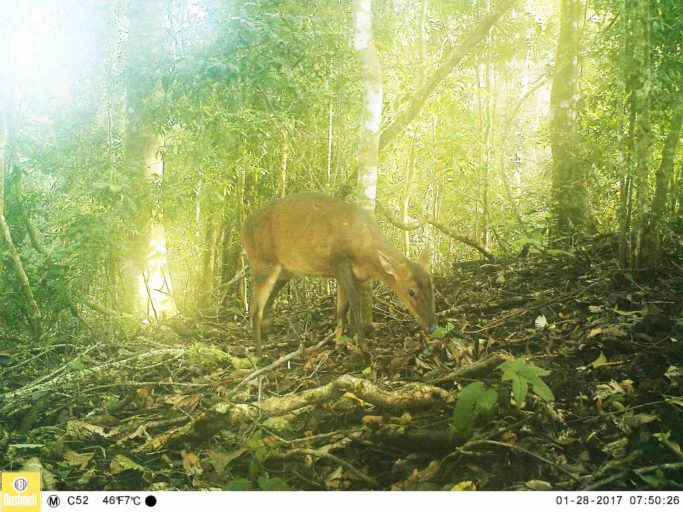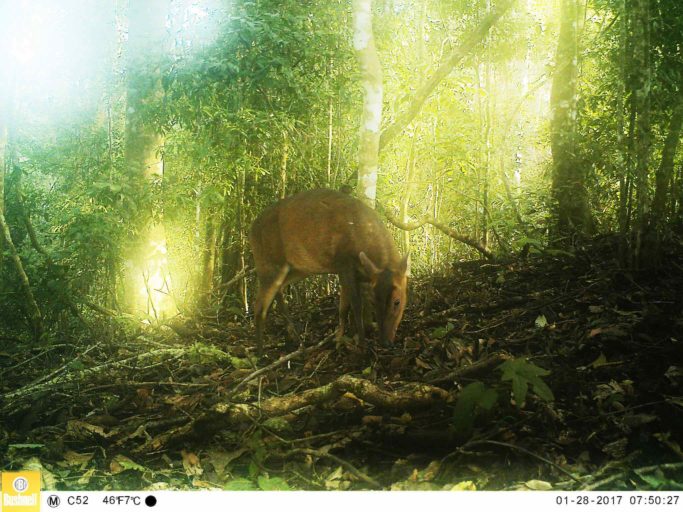- This is only the third site in Vietnam where the giant (or large-antlered) muntjak has been photographed in the last decade, conservationists say.
- The giant muntjac is the largest species of muntjac, or barking deer.
- It lives a cryptic life in the remote rainforests of the Annamite Mountain range in Southeast Asia.
- Overhunting and habitat loss has wiped out the muntjac from across most of its previous range.
The extremely rare giant muntjac is hanging by a thread in Vietnam. But there may be some hope for the critically endangered species.
During a short camera trap survey conducted between December 2016 and February 2017, conservationists photographed the giant muntjak (Muntiacus vuquangensis) in Lang Biang Biosphere Reserve in south-central Vietnam. This is only the third site in Vietnam where this muntjak, or barking deer, has been photographed in the last decade, conservationists say.
“There have been tens of thousands of ‘camera-trap days’ of effort in the Vietnamese Annamites, and we’ve only seen a few photos of the large-antlered muntjac in the last 15 years,” R. J. Timmins, Saola Working Group (SWG) member who was involved in the surveys, said in a statement. “It’s really exciting to get photos of this very rare species with only 14 cameras and little over a month of effort. It suggests the site maybe the best chance for conserving the species in Vietnam.”

The giant muntjac, as its name suggests, is the largest species of barking deer. It lives a cryptic life in the remote rainforests of the Annamite Mountain range in Southeast Asia, a chain of mountains running along the border of the Vietnam and Lao PDR. The Annamite mountains are home to some of the world’s most recent mammal discoveries, including the giant muntjac that was first recorded there in 1994. The Saola and Annamite Striped Rabbit are some of the other recent discoveries from the region.
Unfortunately, overhunting and habitat loss has wiped out the muntjac from across most of its previous range. While there is insufficient data to estimate current accurate population numbers of the barking deer, the species probably lives in small populations at very low densities, according to the International Union for Conservation of Nature (IUCN). Last year, the IUCN up-listed the species from endangered to critically endangered.
The camera traps have also captured other threatened species, including Owston’s civet, Germain’s peacock pheasant, crested argus and hog badger.
“This preliminary survey demonstrates that Lang Biang Biosphere Reserve could be a key site not just for the survival of the large-antlered muntjac but also for other rare species that have disappeared from other parts of Vietnam,” Andrew Tilker, doctoral student at the Leibniz Institute for Zoo and Wildlife Research, and Global Wildlife Conservation associate conservation scientist, said in the statement. “These photos have captured more than just one individual large-antlered muntjac — they have captured hope for the future for this species and many others.”
The survey was conducted by Vietnam-based Southern Institute of Ecology (SIE) in collaboration with the Saola Working Group, Leibniz Institute for Zoo and Wildlife Research and Global Wildlife Conservation.

FEEDBACK: Use this form to send a message to the author of this post. If you want to post a public comment, you can do that at the bottom of the page.